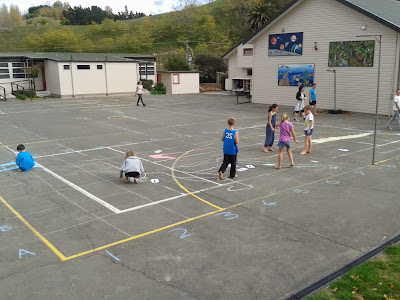Cinq is the French word for "five". A cinquain is a short, five-lined, non-rhyming poem which follows this format:
1st line - The title (one word)
2nd line - Describes the title (two words)
3rd line - Expresses action (three words)
4th line - A feeling or thought (four words)
5th line - A synonym (a word with the same meaning) for the title or a
word close in meaning to it.
Example:
Bats.
Small, black.
Small, black.
Roosting,
gliding, landing.
Flying
fox, fruit eater.
Nocturnal.
Dino
Cinquains written by keen writers in Rm 6.
Allosaurus.
Brown, green.
Strong, muscley legs.
Sharp teeth biting meat.
Carnivore.
Written by Oscar M.
Tyranosaurus-Rex.
Scratchy claws.
Fierce, angry face.
Brave, attacking for meat.
Dangerous.
Written by Oscar M.
Spinosaurus.
Razor teeth.
Stomping, crashing, roaring.
Large, viscious meat eater.
Spined-lizard.
Written by Henry
Velocoraptor.
Hooked claws.
Running, killing prey.
Small, fast, swift seizer.
Carnivore.
Written by Henry
Carnotaurus.
Dangerous killer.
Meat eating bull.
Unique eyes in front.
Horned.
Written by Henry
Tricerotops.
Neck frilled.
Strong, powerful legs.
Fear of meat eaters.
Horned face.
Written by Jordis
Dinosaurs.
Humongous, ugly.
Teeth ripping, cutting.
Earth shakes, ground brakes.
Watch-out!
Written by Hugo
Tricerotops.
Thorny herbivore.
Chewing yummy plants.
Huge, meaty, fat dinosaur.
Three-horned.
Written by Alex O.
Stegasaurus.
Plate stabbing.
Running from predators.
Sad for its friends.
Roofed-lizard.
Written by Alex O.
Saltopus.
Medium size.
Fast, pumped legs.
Sharp claws, big teeth.
Carnivore.
Written by Abigail
Stegosaurus.
Spined lizard.
Eating, thinking, plodding.
Small brain, large body.
Herbivore.
Written by Amy
Triceratops.
Bony head.
Running really fast.
Huge, old, three horned.
Herbivore.
Written by Jordis
Diplodocus.
Big,
loud.
Stomping,
bowling, eating.
Hungry,
seeing green plants.
Herbivore.
Written
by Kadi














